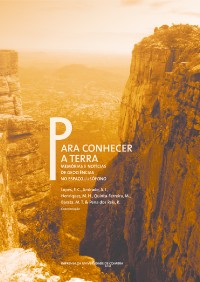Please use this identifier to cite or link to this item:
https://hdl.handle.net/10316.2/31417| Title: | Considerações paleogeográficas sobre os anuros juro-cretáceos da América do Sul e África | Other Titles: | Paleogeographic considerations on jurassic-cretaceous anurans of South America and Africa | Authors: | Leite, K. J. G. Hessel, M. H. Leal, M. E. C. |
Keywords: | Paleogeography;Anurans;Africa;Argentina;Brazil;Paleogeografia;Anuros;África;Argentina;Brasil | Issue Date: | 2012 | Publisher: | Imprensa da Universidade de Coimbra | Journal: | http://hdl.handle.net/10316.2/24406 | Abstract: | Recent studies on the palaeogeography of Africa and South America during
Jurassic and Cretaceous times have suggested that their coastlines at that time were quite
different from today, with seaways cutting central Brazil, and keeping the northeast of South
America along present-day Africa. Thus, this paper presents a summary of the described species
of Jurassic-Cretaceous Anura from Africa and South America, confronting it with this palaeogeography
that redraws the coastline of Western Gondwana. In the Jurassic, all recognized
Anura comes from Argentinean Patagonia: Vieraella herbesti, Notobatrachus degiustoi and
N. reigi. The Archaeobatrachia species occurring in Morocco (Enneabatrachus? sp.) and Argentina
(Vieraella herbesti) suggest a vicariance origin of this suborder related to the Eastern
and Western Gondwana separation. The Mesobatrachia comprise the most diverse biota of
Mesozoic Gondwanan Anura, being represented by Pipoidea, which occur in the Berriasian
of Morocco (Aygroua anoualensis), Aptian of Malawi, Cenomanian of Sudan and Patagonia
(Avitabatrachus uliana), and Coniacian-Maastrichtian of Cameroon, Niger (Pachybatrachus
taqueti), South Africa (Eoxenopoides reuningi and Vulcanobatrachus mandelai), and Argentina
(Saltenia ibanezi). Among the Neobatrachia, the Nobleobatrachia registered in Western
Gondwana occur only in South America: Jurassic of Patagonia (Notobatrachus degiustoi and
N. reigi), Aptian of Araripe (Arariphrynus placidoi and Eurycephalella alcinae) and Late
Cretaceous of Minas Gerais (Baurubatrachus pricei). The described Anura from Araripe, all
Neobatrachia, do not have counterparts in Africa to confirm the hypothesis of a Brazilian
northeast temporarily African in Early Cretaceous time Recentes estudos sobre a paleogeografia dos continentes africano e sul- -americano durante o Jurássico e Cretáceo têm sugerido que suas linhas de costa naquele tempo eram bastante diferentes das atuais, com mares epicontinentais cortando o Brasil central de leste a oeste, e mantendo o nordeste da América do Sul junto à atual África. Deste modo, neste trabalho é apresentada uma síntese da ocorrência de espécies descritas de anuros juro-cretáceos sulamericanos e africanos, confrontando-a com esta paleogeografia que redesenha o litoral do Gondwana Ocidental. No Jurássico, todos os anuros conhecidos se encontram na Patagônia argentina: Vieraella herbesti, Notobatrachus degiustoi e N. reigi. As espécies de Archaeobatrachia ocorrentes no Marrocos (Enneabatrachus? sp.) e na Argentina (Vieraella herbesti) sugerem uma origem vicariante desta subordem relacionada à separação do Gondwana Oriental e Ocidental. Os Mesobatrachia compõem a mais variada biota de anuros gondwânicos mesozóicos, sendo representados pelos Pipoidea, que ocorrem no Berriasiano do Marrocos (Aygroua anoualensis), Aptiano do Malawi, Cenomaniano do Sudão e da Patagônia (Avitabatrachus uliana) e Coniaciano-Maastrichtiano de Camarões, do Níger (Pachybatrachus taqueti), África do Sul (Eoxenopoidesreuningi e Vulcanobatrachus mandelai) e da Argentina (Saltenia ibanezi). Dentre os Neobatrachia, os Nobleobatrachia registrados no Gondwana Ocidental ocorrem somente na América do Sul: Jurássico da Patagônia (Notobatrachus degiustoi e N. reigi), Aptiano do Araripe (Arariphrynus placidoie†Eurycephalella alcinae) e Neocretáceo de Minas Gerais (Baurubatrachus pricei). Os anuros descritos do Araripe, todos Neobatrachia, não têm congêneres na África que permitam confirmar a hipótese de um nordeste brasileiro temporariamente africano no Eocretáceo. |
URI: | https://hdl.handle.net/10316.2/31417 | ISBN: | 978-989-26-0534-0 (PDF) | DOI: | 10.14195/978-989-26-0534-0_16 | Rights: | open access |
| Appears in Collections: | Para conhecer a Terra: memórias e notícias de Geociências no espaço lusófono |
Files in This Item:
| File | Description | Size | Format | |
|---|---|---|---|---|
| 16-para_conhecer_a_terra_artigo.pdf | 562.29 kB | Adobe PDF |  |
Items in DSpace are protected by copyright, with all rights reserved, unless otherwise indicated.
